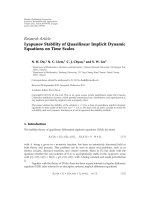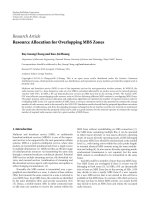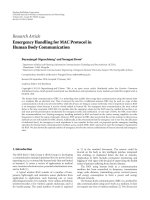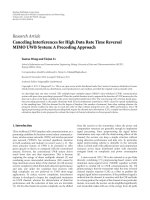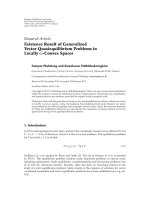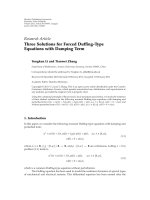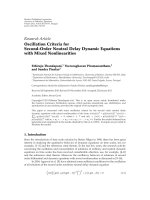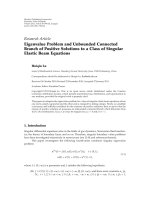Báo cáo hóa học: " Research Article Cauchy-Neumann Problem for Second-Order ¨ General Schrodinger Equations in Cylinders with Nonsmooth Bas" potx
Bạn đang xem bản rút gọn của tài liệu. Xem và tải ngay bản đầy đủ của tài liệu tại đây (548.14 KB, 13 trang )
Hindawi Publishing Corporation
Boundary Value Problems
Volume 2009, Article ID 231802, 13 pages
doi:10.1155/2009/231802
Research Article
Cauchy-Neumann Problem for Second-Order
General Schr
¨
odinger Equations in Cylinders with
Nonsmooth Bases
Nguyen Manh Hung,
1
Tran Xuan Tiep,
2
and Nguyen Thi Kim Son
1
1
Department of Mathematics, Hanoi University of Education, Hanoi, Vietnam
2
Faculty of Applied Mathematics and Informatics, Hanoi University of Technology, Hanoi, Vietnam
Correspondence should be addressed to Nguyen Thi Kim Son, mt02
Received 26 February 2009; Accepted 18 June 2009
Recommended by Gary Lieberman
The main goal of this paper is to obtain the regularity of weak solutions of Cauchy-Neumann
problems for the second-order general Schr
¨
odinger equations in domains with conical points on
the boundary of the bases.
Copyright q 2009 Nguyen Manh Hung et al. This is an open access article distributed under
the Creative Commons Attribution License, which permits unrestricted use, distribution, and
reproduction in any medium, provided the original work is properly cited.
1. Introduction and Notations
Cauchy-Dirichlet problem for general Schr
¨
odinger systems in domains containing conical
points has been investigated in 1, 2. Cauchy-Neumann problems have been dealt with for
hyperbolic systems in 3 and for parabolic equations in 4–6. In this paper we consider the
Cauchy-Neumann problem for the second-order general Schr
¨
odinger equations in infinite
cylinders with nonsmooth bases. The solvability of this problem has been considered in 7.
Our main purpose here is to study the regularity of weak solution of the mentioned problem.
The paper consists of six sections. In Section 1, we introduce some notations and
functional spaces used throughout the text. A weak solution of the problem is defined in
Section 2 together with some results of its unique existence and smoothness with the time
variable. Our main result, the regularity with respect to both of time and spatial variables
of the weak solution of the problem, is stated in Section 3 . The proof of this result is given
in Section 4 with some auxiliary lemmas. In Section 5 we specify that result for the classical
Schr
¨
odinger equations in quantum mechanics. Finally, some conclusions of our results are
given in Section 6.
2 Boundary Value Problems
Let Ω be a bounded domain in R
n
,n 2; Ω and ∂Ω denote the closure and the
boundary of Ω in R
n
. We suppose that Γ∂Ω \{0} is an infinitely differentiable surface
everywhere except the coordinate origin and Ω coincides with the cone K {x : x/|x|∈G}
in a neighborhood of the origin point 0, where G is a smooth domain on the unit sphere S
n−1
in R
n
. We begin by introducing some notations and functional spaces which are used fluently
in the rest.
Denote Q
∞
Ω×0, ∞, Q
∞
is the closure of Q
∞
, S
∞
Γ×0, ∞,xx
1
, ,x
n
∈
Ω,∂
x
j
∂/∂x
j
,u
x
j
∂
x
j
u, u
t
k
∂
k
u/∂t
k
,r |x|
x
2
1
··· x
2
n
. For each multi-index α
α
1
, ,α
n
α
i
∈ N,i 1, ,n,set|α| α
1
··· α
n
, ∂
α
∂
α
x
∂
α
1
x
1
···∂
α
n
x
n
.
In this paper we will use usual functional spaces:
o
C
∞
Ω,L
2
Ω,H
m
Ω, where m ∈ N
see 1, 2 for the precise definitions.
Denote H
l
β
Ω is a space of all measurable complex functions ux, t that satisfy
u
H
l
β
Ω
⎛
⎝
|
α
|
l
Ω
r
2β|α|−l
|∂
α
u|
2
dx
⎞
⎠
1/2
< ∞. 1.1
H
m,l
e
−γt
,Q
∞
γ>0—a space of all measurable complex functions ux, t that have
generalized derivatives up to order m with respect to x and up to order l with respect to t
with the norm
u
H
m,l
e
−γt
,Q
∞
⎛
⎝
Q
∞
⎡
⎣
|
α
|
m
|∂
α
u|
2
l
j1
|u
t
j
|
2
⎤
⎦
e
−2γt
dx dt
⎞
⎠
1/2
< ∞. 1.2
H
l,k
β
e
−γt
,Q
∞
—a space of all measurable complex functions ux, t with the norm
u
H
l,k
β
e
−γt
,Q
∞
⎛
⎝
Q
∞
⎡
⎣
|
α
|
l
r
2β
|
α
|
−l
|
∂
α
u
|
2
k
j1
|
u
t
j
|
2
⎤
⎦
e
−2γt
dx dt
⎞
⎠
1/2
< ∞. 1.3
H
l
β
e
−γt
,Q
∞
—a weighted space with the norm
u
H
l
β
e
−γt
,Q
∞
⎛
⎝
|
α
|
jl
Q
∞
r
2β
|
α
|
j−l
|
∂
α
u
t
j
|
2
e
−2γt
dx dt
⎞
⎠
1/2
< ∞. 1.4
Let X be a Banach space. Denote by L
∞
0, ∞; X a space of all measurable functions u :
0, ∞ → X, t → ut with the norm
u
L
∞
0,∞;X
ess sup
0<t<∞
ut
X
< ∞. 1.5
Boundary Value Problems 3
2. Formulation of the Problem and Obvious Results
In this paper we consider following problem:
iLu − u
t
f in Q
∞
, 2.1
u
x, 0
0onΩ, 2.2
Nu 0onS
∞
, 2.3
where L is a formal self-adjoint differential operator of second-order defined in Q
∞
:
Lu L
x, t, ∂
u
n
j,k1
∂
∂x
j
a
jk
x, t
∂u
∂x
k
a
x, t
u, 2.4
a
jk
x, ta
kj
x, t for all j, k 1, 2, ,n; ax, tax, t, for all x, t ∈ Q
∞
, and
Nu N
x, t, ∂
u
n
j,k1
a
jk
x, t
∂u
∂x
k
cos
x
j
,ν
2.5
is the conormal derivative on S
∞
,νis the unit exterior normal to S
∞
,f is a given function.
Set
B
t, u, v
Ω
⎛
⎝
n
j,k1
a
jk
x, t
∂u
∂x
k
∂v
∂x
j
− a
x, t
uv
⎞
⎠
dx. 2.6
Throughout this paper, we assume that the coefficients of L are infinitely differentiable
and bounded i n
Q
∞
together with all their derivatives. Moreover, suppose that a
jk
are
continuous in x ∈
Ω uniformly with respect to t ∈ 0, ∞ for all j,k 1, ,n.In addition,
assume that Bt, ·, · is H
1
Ω—coercive uniformly with respect to t ∈ 0, ∞, that is,
B
t, u, u
μ
0
u
2
H
1
Ω
∀u ∈ H
1
Ω
,t∈
0, ∞
, 2.7
where μ
0
is a positive constant independent of u and t.
The function ux, t is called aweaksolutionin the space H
1,0
e
−γt
,Q
∞
of the problem
2.1–2.3 if ux, t ∈ H
1,0
e
−γt
,Q
∞
, satisfying for each T ∈ 0, ∞
n
j,k1
Q
∞
a
jk
∂u
∂x
k
∂η
∂x
j
dx dt −
Q
∞
auηdxdt i
Q
∞
uη
t
dx dt i
Q
∞
fηdxdt, 2.8
for all test functions ηx, t ∈ H
1,1
e
−γt
,Q
∞
, ηx, t0 for all t ∈ T, ∞.
Now we derive here some our obvious results of the unique existence and smoothness
with respect to time variable of the weak solution of the problem 2.1–2.3 as lemmas of
main results.
4 Boundary Value Problems
Lemma 2.1. The solvability of the problem, (see [7, Theorems 3.1, 3.2]). There exists a positive number
γ
0
such that if f,f
t
∈ L
∞
0, ∞,L
2
Ω then for every γ>γ
0
, the Cauchy-Neumann problem 2.1–
2.3 has exactly one weak solution ux, t in H
1,0
e
−γt
,Q
∞
, that satisfies
u
2
H
1,0
e
−γt
,Q
∞
C
f
2
L
∞
0,∞,L
2
Ω
f
t
2
L
∞
0,∞,L
2
Ω
, 2.9
where the constant C does not depend on u, f.
The constant γ
0
depends only on the operator L and the dimension of the space n.
Lemma 2.2. The regularity with respect to time variable of the weak solution (see [7, Theorem 4.1]).Let
h be a nonnegative integer. Suppose that f
t
k
∈ L
∞
0, ∞,L
2
Ω for all k h 1,fx, 00 and if
h 2 then f
t
k
x, 00 for all k h − 1, for all x ∈ Ω. Then for every γ>2h 1γ
0
, the weak
solution ux, t of the problem 2.1–2.3 has generalized derivatives with respect to time variable up
to order h, which belong to H
1,0
e
−γt
,Q
∞
, moreover
u
t
s
2
H
1,0
e
−γt
,Q
∞
C
h1
k0
f
t
k
2
L
∞
0,∞,L
2
Ω
, ∀s 0, 1, ,h, 2.10
where C is a constant independent of u, f.
3. Formulation of the Main Result
Let L
0
x, t, ∂ be the principal homogenous part of Lx, t, ∂. We can write L
0
0,t,∂ in the
form
L
0
0,t,∂
r
−2
L
ω, t, ∂
ω
,r∂
r
, 3.1
where r |x|,ωω
1
, ,ω
n−1
is an arbitrary local coordinate system on S
n−1
, L is a linear
operator with smooth coefficients.
Denote λt is an eigenvalue of Neumann problem for following equation:
L
ω, t, λ
t
,∂
ω
v
ω
0,ω∈ G. 3.2
It is well known in 8 that for each t ∈ 0, ∞, the spectrum of this problem is an enumerable
set of eigenvalues.
Recall that γ
0
is the positive real number in Lemma 2.1. Now, let us give the main result
of the present paper.
Theorem 3.1. Let l be a nonnegative integer. Assume that ux, t is a weak solution in the space
H
1,0
e
−γt
,Q
∞
with γ>2l 5γ
0
of the problem 2.1–2.3 and f
t
k
∈ L
∞
0, ∞,H
l
0
Ω if k 3,
f
t
k
x, 00 if k l 1. In addition, suppose that in the strip
1 − ε −
n
2
Imλ l 2 −
n
2
, 3.3
Boundary Value Problems 5
where ε>0 or ε 0 according to n 2 or n>2, there is no point from the spectrum of the Neumann
problem for the equation 3.2 for all t ∈ 0, ∞. Then we have u ∈ H
l2
0
e
−γt
,Q
∞
and the following
estimate holds
u
2
H
l2
0
e
−γt
,Q
∞
C
3
k0
f
t
k
2
L
∞
0,∞,H
l
0
Ω
, 3.4
where C is a constant independent of u, f.
4. Proof of Theorem 3.1
By using the same arguments as in 1, 2 and Lemmas 2.1, 2.2, we can prove following lemma.
Lemma 4.1. Let γ>3γ
0
arbitrary. Assume that ux, t is a weak solution of the problem 2.1–
2.3 in the space H
1,0
e
−γt
,Q
∞
and f, f
t
,f
tt
∈ L
∞
0, ∞,L
2
Ω,fx, 00. Then for almost all
t ∈ 0, ∞ the equation
n
k,j1
Ω
a
jk
∂u
∂x
k
∂χ
∂x
j
dx −
Ω
auχdx i
Ω
u
t
f
χdx 4.1
holds for all functions χ χx ∈ H
1
Ω.
Now we surround the origin by a neighborhood U
0
with a sufficiently small diameter
such that the intersection of Ω and U
0
coincides with the cone K. We begin by proving some
auxiliary lemmas.
Lemma 4.2. Let ux, t be a weak solution in H
1,0
e
−γt
,Q
∞
γ>3γ
0
of the problem 2.1–2.3
such that ux, t0 outside U
0
. Moreover, we assume that f, f
t
,f
tt
∈ L
∞
0, ∞,L
2
Ω,fx, 00.
Then for almost all t ∈ 0, ∞, one has
i if n 3 then u ∈ H
2
1
Ω,
ii if n 2 then u ∈ H
2
1ε
Ω, where ε>0 arbitrary.
Proof. Because f, f
t
,f
tt
∈ L
∞
0, ∞,L
2
Ω,fx, 00, from Lemma 2.2 we have u
t
∈
H
1,0
e
−γt
,Q
∞
or u
t
∈ L
2
Ω for almost all t ∈ 0, ∞. Following Lemma 4.1, ux, t is a
solution of the Neumann problem for elliptic equation
Lu F, 4.2
where F −iu
t
f ∈ L
2
Ω for almost all t ∈ 0, ∞.Denote Ω
k
{x ∈ Ω :2
−k
|x|
2
−k1
}, k 1, 2, Let k
0
be large enough such that Ω
k
0
−1
⊂ U
0
. By choosing a smooth domain
Ω
k
0
such that Ω
k
0
⊂ Ω
k
0
⊂ Ω
k
0
−1
∪Ω
k
0
∪Ω
k
0
1
, from the theory of the regular of solutions of t he
boundary value problem for elliptic systems in smooth domains and near the piece smooth
6 Boundary Value Problems
boundary of domain see 9 for reference, we have u ∈ H
2
Ω
k
0
for almost all t ∈ 0, ∞
and the following inequality holds
u
x, t
|
2
H
2
Ω
k
0
C
Fx, t
2
L
2
Ω
k
0
u
x, t
2
L
2
Ω
k
0
, 4.3
where C is a positive constant independent of u, F. It follows
Ω
k
0
|
∂
α
u
x, t
|
2
dx C
Ω
k
0
−1
∪Ω
k
0
∪Ω
k
0
1
|
Fx, t
|
2
|
ux, t
|
2
dx, ∀
|
α
|
2. 4.4
By choosing k
1
>k
0
and setting x 2
k
0
/2
k
1
x
, one has
Ω
k
0
∂
α
ux
,t
2
dx
C
Ω
k
0
−1
∪Ω
k
0
∪Ω
k
0
1
⎡
⎣
F
x
,t
2
2
k
0
2
k
1
4
u
x
,t
2
⎤
⎦
dx
,
|
α
|
2.
4.5
Return to the variable x,weget
2
k
0
2
k
1
2
|
α
|
Ω
k
1
|
∂
α
ux, t
|
2
dx C
Ω
k
1
−1
∪Ω
k
1
∪Ω
k
1
1
⎡
⎣
|
Fx, t
|
2
2
k
0
2
k
1
4
|
ux, t
|
2
⎤
⎦
dx, 4.6
where the positive constant C is independent of u, f, k
1
.
Case 1 n 3. Then
Ω
r
−2
|
u
|
2
dx C
Ω
r
−n
|
u
|
2
dx < ∞. 4.7
It follows from 4.6 that
Ω
k
1
r
2|α|−1
|
∂
α
u
|
2
dx C
Ω
k
1
−1
∪Ω
k
1
∪Ω
k
1
1
|
F
|
2
r
2
r
−2
|
u
|
2
dx, 4.8
where C does not depend on k
1
. Taking sum with respect to k
1
>k
0
, one has
k
1
>k
0
Ω
k
1
r
2|α|−1
|
∂
α
u
|
2
dx C
k
1
k
0
Ω
k
1
|
F
|
2
r
2
r
−2
|
u
|
2
dx. 4.9
This implies
k>k
0
Ω
k
r
2
|
α
|
−1
|
∂
α
u
|
2
dx C
kk
0
Ω
k
|
F
|
2
r
2
r
−2
|
u
|
2
dx. 4.10
Boundary Value Problems 7
Because in out of a neighborhood of conical point Ω is a smooth domain, so we have
Ω
r
2
|
α
|
−1
|
∂
α
u
|
2
dx C
Ω
|
F
|
2
r
2
r
−2
|
u
|
2
dx 4.11
for all |α| 2, almost all t ∈ 0, ∞. From 4.7, 4.11 and F ∈ L
2
Ω we receive u ∈ H
2
1
Ω
for almost all t ∈ 0, ∞.
Case 2 n 2. Since u ∈ H
1,0
e
−γt
,Q
∞
so for almost all t ∈ 0, ∞ one has
Ω
r
0
|∂
β
u|
2
dx <
∞, |β| 1. This implies
K
r
2ε
|∂
β
u|
2
dx C
K
|∂
β
u|
2
dx < ∞, where ε>0 arbitrary, C is a
positive constant. Because u ≡ 0 outside U
0
, so we have
Ω
r
2ε
∂
β
u
2
dx C
Ω
∂
β
u
2
dx < ∞. 4.12
For all ε>0 we have 2ε>0 1 − n/2, so it follows from 8, Lemma 7.1.1, page 268 that
Ω
r
2ε−1
|
u
|
2
dx C
|β|1
Ω
r
2ε
∂
β
u
2
dx C
|β|1
Ω
∂
β
u
2
dx < ∞. 4.13
From the inequality 4.6, for all |α| 2onegets
Ω
k
1
r
2
|
α
|
−1ε
|
∂
α
u
|
2
dx C
Ω
k
1
−1
∪Ω
k
1
∪Ω
k
1
1
|
F
|
2
r
2ε1
r
2ε−1
|
u
|
2
dx, 4.14
where C does not depend on u, f, k
1
. By using analogous arguments used in Case 1,from
4.13, 4.14 we have
Ω
r
21ε
|
α
|
−2
|
∂
α
u
|
2
dx C
Ω
⎡
⎣
|
F
|
2
|β|1
∂
β
u
2
⎤
⎦
dx < ∞, 4.15
for all |α| 2, almost all t ∈ 0, ∞. That is u ∈ H
2
1ε
Ω. The lemma is proved.
Lemma 4.3. Let f
t
k
∈ L
∞
0, ∞,L
2
Ω,k 3, and fx, 0f
t
x, 00 for x ∈ Ω. Assume that
ux, t isaweaksolutioninH
1,0
e
−γt
,Q
∞
γ>5γ
0
of the problem 2.1–2.3 such that u ≡ 0
outside U
0
. In addition, suppose that the strip
1 − ε −
n
2
Imλ 2 −
n
2
, 4.16
where ε 0 or ε>0 according to n 3 or n 2, does not contain any point of the spectrum of the
Neumann problem for the equation 3.2 for all t ∈ 0, ∞.Thenu ∈ H
2
0
e
−γt
,Q
∞
.
8 Boundary Value Problems
Proof. We can rewrite 2.1 in the form
L
0
0,t,∂
u
F
x, t
−i
u
t
f
L
0
0,t,∂
− L
x, t, ∂
u. 4.17
If n 3 then by applying Lemma 4.2 we have u ∈ H
2
1
Ω. In another way, because
a
jk
are continuous in x ∈ Ω uniformly with respect to t ∈ 0, ∞ for all j, k 1, ,nthen
|a
jk
x, t − a
jk
0,t| C|x|, for all t ∈ 0, ∞ and C is a constant independent of t. Therefore,
from the hypotheses of this lemma one gets
F ∈ L
2
Ω for almost all t ∈ 0, ∞. Since in the
strip 1 − n/2 Imλ 2 − n/2 there is no spectral point of the Neumann problem for the
equation 3.2 for all t ∈ 0, ∞, then following results of the work 9,onegetsu ∈ H
2
0
Ω
and satisfies
u
2
H
2
0
Ω
C
F
2
L
2
Ω
u
2
H
2
1
Ω
, 4.18
for almost all t ∈ 0, ∞, where C is a positive constant. Using the same arguments in the
proof of Lemma 4.2, we have
u
2
H
2
0
Ω
C
u
t
2
L
2
Ω
f
2
L
2
Ω
u
2
H
1
Ω
, 4.19
for almost all t ∈ 0, ∞. Multiplying this inequality with e
−2γt
, then integrating with respect
to t from 0 to ∞,fromLemma 2.2 one gets
u
2
H
2,0
0
e
−γt
,Q
∞
C
3
k0
f
t
k
2
L
∞
0,∞,L
2
Ω
< ∞. 4.20
Then u is a function in the space H
2,0
0
e
−γt
,Q
∞
.
If n 2 then following Lemma 4.2 we have u ∈ H
2
1ε
Ω for almost all t ∈ 0, ∞.
This and the property of the functions a
jk
continuous in x ∈ Ω uniformly with respect to
t ∈ 0, ∞ follows
F ∈ H
0
1
Ω. Because the strip 1 − ε − n/2 Imλ 1−n/2 does not contain
any spectral point of the Neumann problem for 3.2, so from results of the work 9 we have
u ∈ H
2
1
Ω satisfying
u
2
H
2
1
Ω
C
F
2
H
0
1
Ω
u
2
H
2
1ε
. 4.21
Repeating the proof in the case n 3 we achieve u ∈ H
2,0
0
e
−γt
,Q
∞
, too.
Now differentiating 2.1 with respect to t, we have
Lv F
1
−i
v
t
f
t
L
t
u, 4.22
where v u
t
,L
t
n
j,k1
∂/∂x
j
a
jk
t
∂/∂x
k
a
t
. From the hypotheses of the operator L
and Lemma 2.2 we have F
1
∈ L
2
Ω for almost all t ∈ 0, ∞. Repeating arguments used for
function u we receive v ∈ H
2,0
0
e
−γt
,Q
∞
or u
t
∈ H
2,0
0
e
−γt
,Q
∞
.
Boundary Value Problems 9
In another way, it follows from Lemma 2.2 that
Q
∞
|
u
t
2
|
2
e
−2γt
dx dt < ∞. 4.23
From 4.23 and the assertion that both u and u
t
are in the space H
2,0
0
e
−γt
,Q
∞
we
have u ∈ H
2
0
e
−γt
,Q
∞
. This lemma is proved.
Lemma 4.4. Let l be a nonnegative integer number, γ be a real number satisfying γ>2l 5γ
0
,
ux, t be a weak solution in H
1,0
e
−γt
,Q
∞
of the problem 2.1–2.3 such that u ≡ 0 outside U
0
.
Assume that f
t
k
∈ L
∞
0, ∞,H
l
0
Ω,k 3, and f
t
k
x, 00 for k l 1,x∈ Ω. Moreover,
suppose that the strip
1 − ε −
n
2
Imλ l 2 −
n
2
4.24
does not contain any point of the spectrum of the Neumann problem for the equation 3.2 for all
t ∈ 0, ∞,whereε 0 or ε>0 according to n 3 or n 2.Thenu ∈ H
l2
0
e
−γt
,Q
∞
, satisfying
u
2
H
l2
0
e
−γt
,Q
∞
C
3
k0
f
t
k
2
L
∞
0,∞,H
l
0
Ω
, 4.25
where the constant C is independent of u, f.
Proof. We use the induction by l. For l 0 then we had Lemma 4.3 with noting that H
0
0
Ω ≡
L
2
Ω. Assume that lemma’s assertion holds up to l − 1, we need to prove this holds up to l.
It means that we have to prove following inequality:
u
t
j
2
H
l2−j
0
e
−γt
,Q
∞
C
3
k0
f
t
k
2
L
∞
0,∞,H
l
0
Ω
, 4.26
for j l,l − 1, ,0, where C is a positive constant.
Since f
t
k
∈ L
∞
0, ∞,H
l
0
Ω for k 3, so f
t
k
∈ L
∞
0, ∞,L
2
Ω for k l 3. In another
way, f
t
k
x, 00fork l 1. Then from Lemma 2.2 we have u
t
l1
∈ H
1,0
e
−γt
,Q
∞
,u
t
s
∈
H
1,0
e
−γt
,Q
∞
for all s l. Hence, by using similar arguments in the proof of Lemma 4.3 we
get u
t
l
∈ H
2
0
e
−γt
,Q
∞
. This means that 4.26 holds for j l.
Assume that 4.26 holds for j l,l − 1, ,s 1. By putting v u
t
s
∈ H
l−s1
0
e
−γt
,Q
∞
by inductive hypothesis and differentiating 2.1 s-times with respect to t, we have
Lv −i
v
t
f
t
s
s
p1
C
p
s
L
t
p
u
t
s−p
, 4.27
where L
t
p
n
j,k1
∂/∂x
j
a
jk
t
p
∂/∂x
k
a
t
p
. Following the assumptions of the induction
of s and the hypotheses of the function f one has v
t
∈ H
l−s1
0
e
−γt
,Q
∞
,f
t
s
∈ H
l−s
0
e
−γt
,Q
∞
.
It follows F
s
−iv
t
f
t
s
s
p1
C
p
s
L
t
p
u
t
s−p
∈ H
l−s
0
e
−γt
,Q
∞
. In another way since
10 Boundary Value Problems
H
l−s
0
e
−γt
,Q
∞
⊆ H
l−s−1,0
−1
e
−γt
,Q
∞
, so we have F
s
∈ H
l−s−1
−1
e
−γt
,Q
∞
for almost all t ∈
0, ∞. Because the strip l 1 − s − n/2 Imλ l 2 − s − n/2 does not contain any
point of the spectrum of the Neumann problem for 3.2 for all t ∈ 0, ∞, then following
results of the work 9,onegetsv ∈ H
l1−s
−1
Ω. This implies v ∈ H
l1−s,0
−1
e
−γt
,Q
∞
.Note
that F
s
∈ H
l−s,0
0
e
−γt
,Q
∞
then by applying 8, Theorem 7.3.2 one gets v ∈ H
l2−s,0
0
e
−γt
,Q
∞
satisfying
v
2
H
l2−s,0
0
e
−γt
,Q
∞
C
F
s
2
H
l−s,0
0
e
−γt
,Q
∞
v
2
H
l1−s,0
−1
e
−γt
,Q
∞
, 4.28
where C is a positive constant. In another way, it is easy to see that
u
t
s
2
H
l2−s
0
e
−γt
,Q
∞
u
t
s1
2
H
l2−s−1
0
e
−γt
,Q
∞
u
t
s
2
H
l2−s,0
0
e
−γt
,Q
∞
. 4.29
Hence from the inductive assumptions we receive
u
t
s
2
H
l2−s
0
e
−γt
,Q
∞
C
3
k0
f
t
k
2
L
∞
0,∞,H
l
0
Ω
, 4.30
where C is a constant independent of u, f. It means that 4.26 is proved. Finally we only need
to fix j 0in4.26 to complete the proof of this lemma.
Now let us prove Theorem 3.1.
Proof. Denote u
0
ϕ
0
u, where ϕ
0
∈
o
C
∞
U
0
and ϕ
0
≡ 1 in a neighborhood of coordinate
origin. The function u
0
satisfies
iLu
0
−
u
0
t
ϕ
0
f L
1
u, 4.31
where L
1
u is a linear differential operator order 1. Coefficients of this operator depend on the
choice of the function ϕ
0
and equal to 0 outside U
0
. Denote u
1
ϕ
1
u 1−ϕ
0
u.Itiseasytosee
that u
1
is equal to 0 in a neighborhood of conical point. Therefore we can apply the theorem
on the smoothness of a solution of elliptic problem in a smooth domain to this function to
conclude that u
1
ϕ
1
u ∈ H
l2
0
Ω for almost all t ∈ 0, ∞. By applying Lemma 2.2 we
receive u
1
∈ H
l2
0
e
−γt
,Q
∞
and
u
1
2
H
l2
0
e
−γt
,Q
∞
C
3
k0
f
t
k
2
L
∞
0,∞,H
l
0
Ω
,C const > 0. 4.32
Now, let us prove Theorem 3.1 by induction by l. When l 0 then functions u
0
,
f
ϕ
0
f L
1
u satisfy the hypotheses of Lemma 4.3.Sou
0
∈ H
2
0
e
−γt
,Q
∞
. It follows that u
u
0
u
1
is in H
2
0
e
−γt
,Q
∞
. Assume that the theorem holds up to l − 1 then we have u ∈
H
l1
0
e
−γt
,Q
∞
. By using analogous arguments in the proof of Lemma 4.4,withnotethat
f
t
s
∈
H
l−s
0
e
−γt
,Q
∞
from the hypothesis of induction, we can prove that u
0
∈ H
l2
0
e
−γt
,Q
∞
.So
Boundary Value Problems 11
u ∈ H
l2
0
e
−γt
,Q
∞
. The inequality in Theorem 3.1 can derive from inequality 4.25for u
0
and inequality 4.32. The theorem is proved completely.
5. Cauchy-Neumann Problem For Classical Schr
¨
odinger Equation In
Quantum Mechanics
In this section we apply the previous result to the Cauchy-Neumann problem for classical
Schr
¨
odinger equations in quantum mechanics. It is shown that the smoothness of the weak
solution of this problem depends on the structure of the boundary of the domain, the right
hand side and the dimension n of the space R
n
.
The classical Schr
¨
odinger equation in quantum mechanics has the form
iΔu
x, t
− u
t
x, t
f
x, t
, 5.1
where Δ is the Laplace operator. Now we consider the Cauchy-Neumann problem for 5.1
in infinite cylinder Q
∞
with the initial condition
u
x, 0
0onΩ, 5.2
and the boundary condition
∂u
∂ν
n
k1
∂u
∂x
k
cos
x
k
,ν
0onS
∞
, 5.3
where ν is the unit exterior normal to S
∞
.
The Laplace operator in polar coordinate r, ω in R
n
can be written in the form
Δu
r, ω
1
r
n−1
∂
∂r
r
n−1
∂
∂r
u
r, ω
1
r
2
Δ
ω
u
r, ω
, 5.4
where Δ
ω
is the Laplace-Beltrami operator on the unit sphere S
n−1
. Therefore, the
corresponding spectral problem for 3.2 is the Neumann problem for following equation:
Δ
ω
v
iλ
2
i
2 − n
λ
v 0,ω∈ G. 5.5
The regularity of the weak solution of the problem 5.1–5.3 can be stayed as follows.
Theorem 5.1. Let n>4,ube a weak solution in the space H
1,0
e
−γt
,Q
∞
γ>5γ
0
of the Cauchy-
Neumann problem 5.1–5.3 and f
t
k
∈ L
∞
0, ∞,L
2
Ω if k 3, fx, 0f
t
x, 00.Then
u ∈ H
2
0
e
−γt
,Q
∞
.
Proof. Note k be nonnegative eigenvalues of the Neumann problem for equation
Δ
ω
v kv 0,ω∈ G. 5.6
12 Boundary Value Problems
Then λ i2 − n/2 ±
n − 2/2
2
k are eigenvalues of the Neumann problem for 5.5.
It is easy to see that when n>4 the strip
1 −
n
2
Imλ 2 −
n
2
5.7
does not contain any eigenvalue of the Neumann problem for 5.5. By applying Theorem 3.1
we have u ∈ H
2
0
e
−γt
,Q
∞
. The theorem is proved.
6. Conclusions
The Schr
¨
odinger equation has received a great deal of attention from mathematicians,
in particular because of its application to quantum mechanics and optics. It is therefore
important to research boundary value problems for it. Such problems have been previously
proposed and analyzed for Schr
¨
odinger equations whose coefficients are independent of the
time variable and in finite cylinders Q
T
T<∞see, e.g., 10. In infinite cylinder Q
∞
,
the first initial boundary value problem for this kind of equation with coefficients depend on
both of time and spatial variables has been considered see 1, 2. In this paper, for a general
Schr
¨
odinger equation in infinite cylinder Q
∞
with conical points in the boundary of base,
we proved regularity property of solution of second initial boundary value problem. As a
special application of these new results, we received the regularity of solution of a classical
Schr
¨
odinger equation in quantum mechanics when the dimension of space n>4. The similar
questions for the case n 4 can be answered after researching the asymptotic of solution in
the case the strip 1 − n/2 Imλ 2 l − n/2 contains eigenvalues of the associated spectral
problem. This is also the aim of our future research.
References
1 N. M. Hung, “The first initial boundary value problem for Schr
¨
odinger systems in non-smooth
domains,” Diff.Urav., vol. 34, pp. 1546–1556, 1998 Russian.
2 N. M. Hung and C. T. Anh, “On the smoothness of solutions of the first initial boundary value
problem for Schr
¨
odinger systems in domains with conical points,” Vietnam Journal of Mathematics,
vol. 33, no. 2, pp. 135–147, 2005.
3 A. Yu. Kokotov and B. A. Plamenevski
˘
ı, “On the asymptotic behavior of solutions of the Neumann
problem for hyperbolic systems in domains with conical points,” Algebra i Analiz, vol. 16, no. 3, pp.
56–98, 2004 Russian, English translation in St. Petersburg Mathematical Journal, vol. 16, no. 3, pp.
477–506, 2005.
4 E. V. Frolova, “An initial-boundary value problem with a noncoercive boundary condition in a
domain with edges,” Zapiski Nauchnykh Seminarov (POMI), vol. 213, no. 25, pp. 206–223, 1994.
5 N. M. Hung and N. T. Anh, “Regularity of solutions of initial-boundary value problems for parabolic
equations in domains with conical points,” Journal of Differential Equations, vol. 245, no. 7, pp. 1801–
1818, 2008.
6 V. A. Solonnikov, “On the solvability of classical initial-boundary value problem for the heat equation
in a dihedral angle,” Zapiski Nauchnykh Seminarov Leningradskogo Otdeleniya Matematicheskogo Instituta,
vol. 127, pp. 7–48, 1983.
7 N. M. Hung and N. T. K. Son, “Existence and smoothness of solutions to second initial boundary
value problems for Schr
¨
odinger systems in cylinders with non-smooth bases,” Electronic Journal of
Differential Equations, vol. 2008, no. 35, pp. 1–11, 2008.
8 V. A. Kozlov, V. G. Maz’ya, and J. Rossmann, Elliptic Boundary Value Problems in Domains with
Point Singularities, vol. 52 of Mathematical Surveys and Monographs, American Mathematical Society,
Providence, RI, USA, 1997.
Boundary Value Problems 13
9 L. Nirenberg, “Remarks on strongly elliptic partial differential equations,” Communications on Pure
and Applied Mathematics, vol. 8, pp. 648–674, 1955.
10 J. L. Lions and E. Magenes, Non-Homogeneous Boundary Value Problems and Applications, vol. 1-2,
Springer, New York, NY, USA, 1972.
